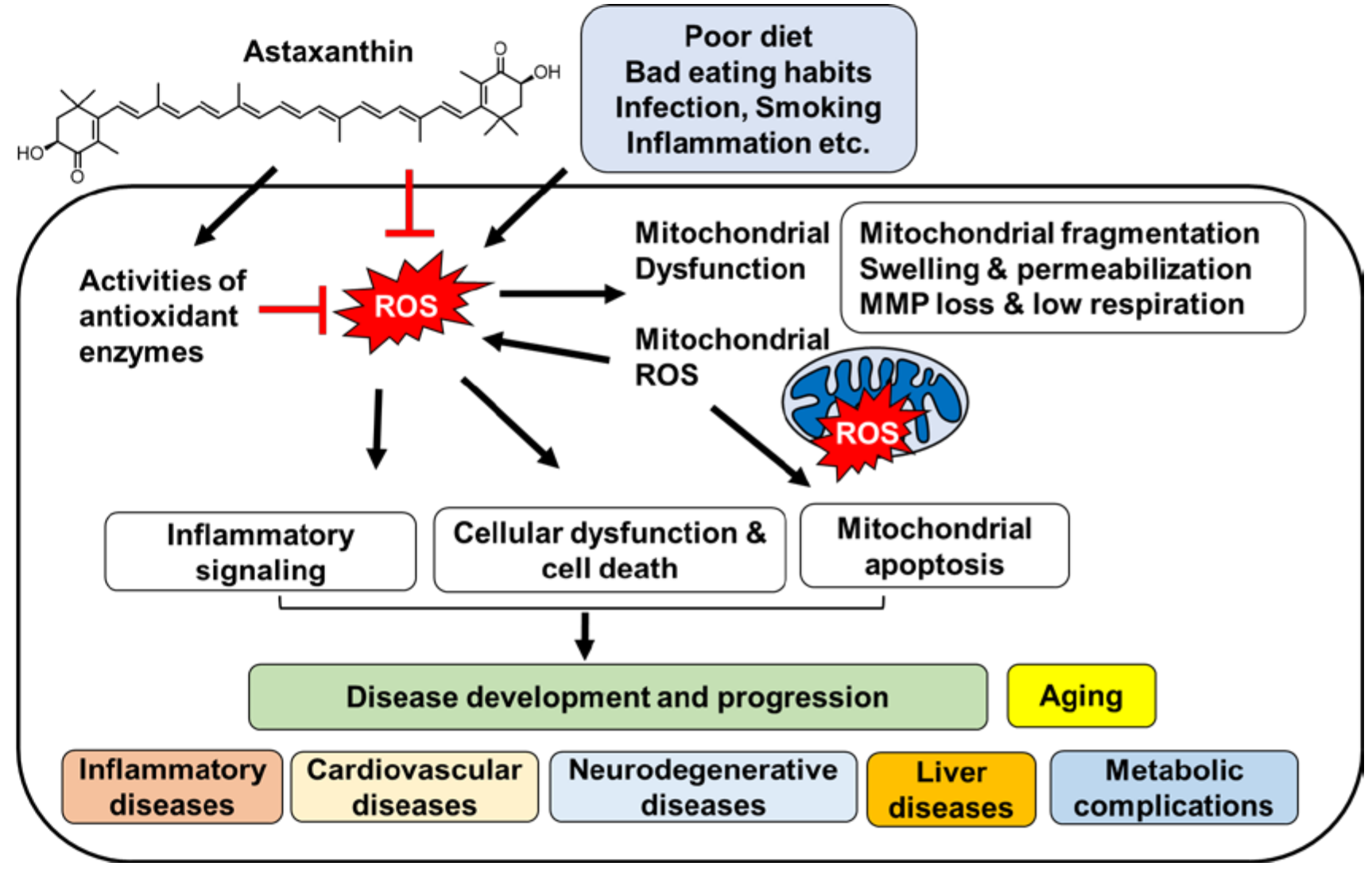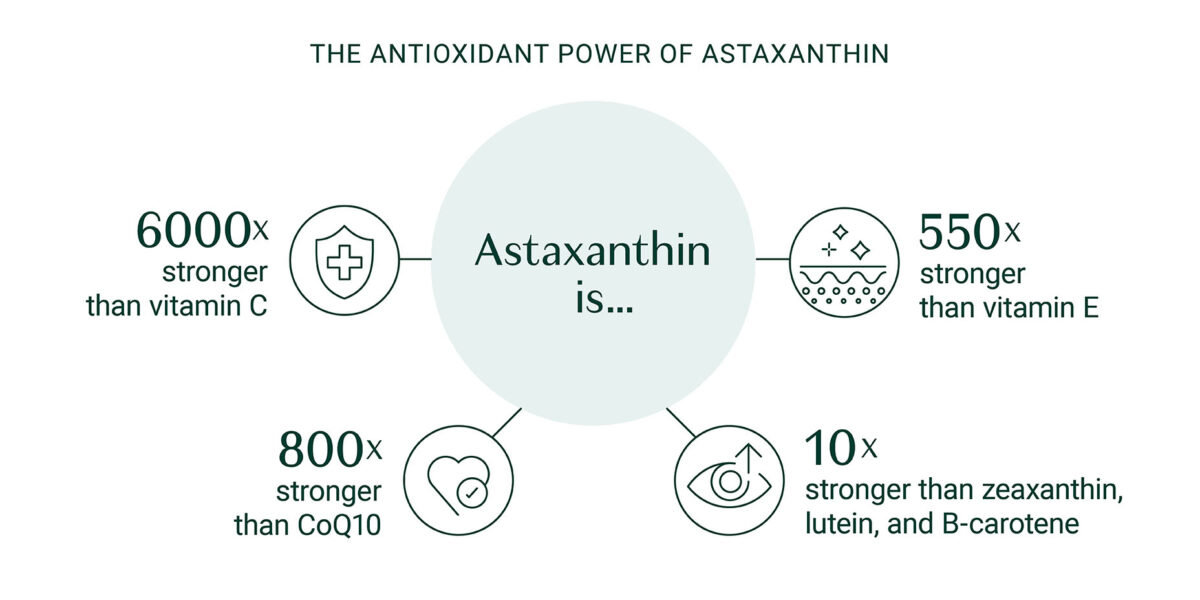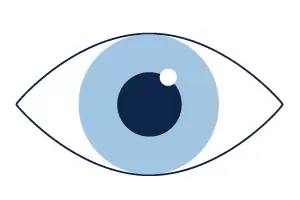Is astaxanthin a powerful antioxidant?
Astaxanthin is a natural carotenoid (a class of antioxidants) that is a very colorful red-orange pigment. It is considered to be the most powerful antioxidant as compared to beta carotene and lycopene.
Astaxanthin is distinguished by its characteristic reddish-orange hue. It is naturally produced by a microalga, Haematococcus pluvialis, in response to extreme environmental conditions. This pigment is then accumulated by marine organisms such as krill, plankton, crustaceans, shellfish, trout, and wild salmon. It's this very astaxanthin that imparts the distinctive pinkish coloration to these species. In other words, the vibrant color we observe in wild salmon flesh is not merely aesthetic; it serves as a biological marker of defense and resilience.
In this blog allow us to acquaint you with one of nature’s most potent antioxidants, and the many reasons why astaxanthin would be a fabulous addition to any supplement regime. The latest research shows promising results for those everyday concerns such as ageing skin, low immunity, tiredness and fatigue, aching joints, low fertility, poor cognitive function and below-par exercise performance. I could go on, but I feel I may have already caught your attention.
What Is Astaxanthin?
Astaxanthin is a bright red carotenoid pigment (natural colour) derived from haematococcus pluvialis (H. pluvialis), an algae with the highest levels of astaxanthin, accumulated in response to stressors from its environment, such as starvation, high levels of salt, high temperature and radiation. The accumulation of astaxanthin turns the algae from green to red, and is responsible for the bright pink-red colouring of many marine animals such as salmon, crab and lobster and the brightly coloured feathers of flamingos, which obtain astaxanthin through their diet. Aside from its wonderful colouring, its main action is that of an antioxidant and, as such, protecting algae from environmental stressors.
20 years, 100 clinical studies and 500 pre-clinical studies later, scientific results are in and they’re clear-cut : astaxanthin has an outstanding capacity to trap singlet oxygen (aka a molecule that oxidizes various important biological molecules in our body).
Today Astaxanthin is the most powerful antioxidant molecule that nature can offer us. Comparative studies have shown that astaxanthin’s antioxidant power is 6,000 times more powerful than vitamin C, 100 times more powerful than vitamin E, and five times more powerful than beta-carotene in neutralizing reactive oxygen species.
Astaxanthin has been compared with 7 common antioxidants and its effect in fighting free radicals is 10 times higher than that of beta-carotene, between 80-550 times more powerful than vitamin E, higher than the action of vitamin C , 75 times more than alpha-acidlipoic and even 800 more than coenzyme Q10.

1. How Powerful Astaxanthin Is?
Astaxanthin is 6,000 times stronger than vitamin C;
Astaxanthin is 800 times stronger than coenzyme Q10;
Astaxanthin is 550 times more effective than vitamin E;
These staggering numbers made it one of the most effective natural antioxidants for mankind, a trump card for a range of health applications.
2. Astaxanthin Molecular Structure
Astaxanthin is a carotenoid that belongs to the xanthophyll family. Its molecular structure keeps free radicals in check with very unique features:
The lipophilic polyene chain makes it oil-soluble and fat-soluble
It acts upon cell membranes through its hydrophilic ends
The outcomes? Astaxanthin captures free radicals inside and outside the lipid bilayer of the human body membranes.
How? By penetrating and passing right through them. Astaxanthin acts as a “wall pass” that crosses the blood-brain and blood-retina barriers to release its power.

How Astaxanthin Works As An Antioxidant
Similar to algae, the human body is also subject to environmental stressors, though ours include poor diet, pollution, stress, exercise, smoking, alcohol, drug use (prescription and non-prescription) and so on. The body also has inbuilt antioxidant capabilities which it works hard to keep in balance; however, an over-burdened body can lead to oxidative stress, which in turn, can lead to cellular damage. Long-term, oxidative stress is associated with major health conditions including cancer, autoimmune conditions such as rheumatoid arthritis, neurological conditions including Alzheimer’s and Parkinson’s disease, and cardiovascular disease, as well as ageing, poor fertility health and inflammation. Whilst there are many things you can do to reduce the causes of oxidative stress, like eating a healthy diet, purchasing organic food, getting adequate sleep, not smoking, using chemical-free cosmetics and cleaning products, other sources of oxidation, such as breathing and exercising, cannot be avoided.

Why Is Astaxanthin Considered the Most Powerful Natural Antioxidant?
From a scientific perspective, astaxanthin is a remarkable molecule. Its structure enables it to operate across the entirety of a cell—both outside and within. Unlike water-soluble vitamin C or fat-soluble vitamin E, astaxanthin combines both solubility properties, ensuring comprehensive cellular protection. It can neutralize several types of free radicals, stabilize cell membranes, inhibit inflammatory cascades, and remain active in the body for extended periods.
Research shows that its antioxidant power is up to 6,000 times stronger than vitamin C, 800 times stronger than coenzyme Q10, and 75 times stronger than alpha-lipoic acid. These aren't just theoretical claims—they are backed by clinical observations showing improved skin health, enhanced muscle recovery, better vision, brain protection, and reduced chronic inflammation.

How Astaxanthin Works On A Cellular Level
Astaxanthin works in several ways to combat free radicals. Like all antioxidants, astaxanthin works in the body by donating a chemical group to free radicals (compounds that have lost a chemical group and without it become unstable and lead to oxidative damage). When many antioxidants do this, they themselves become pro-oxidant unless they are recycled by another antioxidant; astaxanthin, importantly, has an unlimited ability to provide chemical groups without itself becoming a pro-oxidant. Astaxanthin also works by calming free radicals, absorbing the negative energy they emit. Fat-soluble antioxidants tend to protect the inner wall of the cell membrane, whilst water-soluble antioxidants protect the outer wall of the cell membrane. However, with its unique structure, astaxanthin is able to span the cell membrane, thus providing antioxidant protection to both the inner and the outer wall, as well as the intra-membrane space. All of these factors make astaxanthin ‘the king of antioxidants’.
An illustration of astaxanthin spanning both the cell membrane and intra-cellular space of a cell
Astaxanthin Benefits
High levels of oxidative stress can lead to inflammation; as a health-oriented company, we value the ability of nutritional science to help support the healthy balance of inflammation within the body, because inflammation underpins most health conditions. Studies have successfully shown astaxanthin’s ability to not only reduce biomarkers associated with oxidative stress but also biomarkers associated with inflammation. As such, the antioxidant and anti-inflammatory properties of astaxanthin have shown promise in many areas of health. Here is an overview of some of the areas of research:
Astaxanthin for exercise – Exercise leads to the production of reactive oxygen-nitrogen species (RONS) within the muscle, which promotes improvement in athletic performance. Without the body’s own antioxidant capabilities, RONS can cause a state of oxidative stress, and the body can become overloaded during times of vigorous exercise, thus leading to oxidation, damaging molecules and potentially a negative impact on physiological function. Astaxanthin is not only a powerful antioxidant, but as it also upregulates the body’s own antioxidant capabilities, it helps to rebalance the oxidative stress caused by an over-production of RONS, with 3-5 weeks of astaxanthin supplementation shown to improve exercise metabolism, performance and recovery.

Astaxanthin Benefits Skin – If there was ever a supplement we would all be taking, it would be an anti-ageing one. Skin ageing occurs over time, but the ageing process is accelerated by certain lifestyle factors, and exposure to agents which cause oxidative stress in the skin, like, for example, smoking, drinking alcohol, UV exposure from the sun, and poor diet, amongst others. Studies illustrate that supplementation and topical application of astaxanthin improved the appearance of ‘crow’s feet’, improved elasticity, skin texture and moisture content over 8 weeks. Who doesn’t want to keep that fresh-faced and crease-free complexion for longer?

Astaxanthin for neuroprotection – Astaxanthin is a fat-soluble molecule, enabling it to pass the blood-brain barrier where it can exert its beneficial effects neurologically. Studies have demonstrated that for those who have supplemented with astaxanthin prior to a stroke, there is reduced production of reactive oxygen species (ROS), the build-up of which can lead to tissue damage and therefore loss of function, following a stroke. Furthermore, supplementing with astaxanthin following a haemorrhage may alleviate early brain injury with its ability to upregulate the body’s own antioxidant capabilities, as well as exert anti-inflammatory effects.
Astaxanthin for cardiovascular disease – Studies suggest that taking astaxanthin before an ischaemic event, such as a stroke, provides protection to the muscle tissue of the heart. It has also been shown to have a positive effect on cholesterol levels by decreasing overall triglycerides and increasing HDL (‘good’) cholesterol, which provides protection against atherosclerosis as HDL cholesterol carries LDL (‘bad’) cholesterol back to the liver to prevent it from forming plaques in the arteries.

Astaxanthin Benefits Eyes– Studies suggest astaxanthin protects the cells of the eye following an ischaemic attack, and that it also inhibits retinal damage following white light exposure. A 6mg daily dose of astaxanthin for 4 weeks has also been shown to improve the function of the eye in middle-aged participants with eye strain complaints.

Astaxanthin for immunity – Supplementing with astaxanthin has been shown to boost the immune response and reduce DNA damage when exposed to infection.
What Is The Ideal Dosage Of Astaxanthin?
In general, experts recommend taking 4 to 8 mg of astaxanthin per day. This is also considered the ideal dose for athletes who are under high oxidative stress, for people who are exposed to excessive sunlight or for people such as pilots who are exposed to large amounts of ionising radiation.
Since astaxanthin accumulates in the body, its benefits increase when it is taken on a regular basis. If you have specific health problems, you can start with a higher dose for a few weeks and then gradually reduce it.
So far, no one has set a maximum value or determined the maximum dose of astaxanthin that the body can absorb. Remember: Astaxanthin is not a medication, it is a vital substance that naturally occurs in foods that have been eaten for thousands of years.
In various clinical studies in humans taking astaxanthin to determine its effect on various health problems, the dosage ranged from 1.8 mg - 100 mg per day, which was given either in a single dose or distributed throughout the day.
People suffering from arthritis, tendonitis or carpal tunnel syndrome could therefore start with an astaxanthin dose of 12 mg per day, whereas someone who is taking astaxanthin only for its antioxidant effects or for anyone who wants to strengthen their immune system can start with a dose of 4 mg per day.
As mentioned elsewhere, astaxanthin is also a component of krill oil. Depending on the krill oil brand, the astaxanthin per recommended dose krill oil ranges between 40 micrograms and 1.2 milligrams per dose.
Conclusion
Astaxanthin is far more than a simple supplement. It represents the powerful synergy between marine biology and modern health science. With its broad-spectrum efficacy, ability to cross biological barriers, and support for key functions such as inflammation control, skin protection, muscle recovery, and cognitive health, it stands out as one of the most comprehensive natural antioxidants available today.
Incorporating astaxanthin into your wellness routine, alongside a colorful, nutrient-rich diet and a balanced lifestyle, may offer tangible and lasting benefits. The goal is not to chase miracle cures, but to make informed, consistent choices that support the body's natural resilience. In this sense, astaxanthin reminds us that nature holds powerful tools—when we take the time to understand and use them wisely.
To explore our curated selection of astaxanthin powder, contact us today! email: info@yanggebiotech.com
References
Nishida Y., Yamashita E., and Miki, W. (2007). ‘Quenching activities of common hydrophilic and lipophilic antioxidants against singlet oxygen using chemiluminescence detection system’, Carotenoid science, 11, pp. 16-20.
Brown D. R., Gough L.A., Deb S.K., et al. (2018). ‘Astaxanthin in exercise metabolism, performance and recovery: a review’, Frontiers in nutrition, 4 (76), pp. 1-9.
Tominaga K., Hongo N., Karato M., et al. (2012). ‘Cosmetic benefits of astaxanthin on humans subjects’, Acta biochimica polonic, 59 (1), pp. 43-47.
Haijian W., Huanjiang N., Anwen S., et al. (2015). ‘Astaxanthin as a Potential Neuroprotective Agent for Neurological Diseases’, Marine drugs, 13 (9), pp. 5750-5766.
Fassett R.G. & Coombes J.S. (2011). ‘’Astaxanthin: A Potential Therapeutic Agent inCardiovascular Disease’, Marine drugs, 9 pp. 447-465.
Yoshida H., Yanai H., Ito K., et al. (2010). ‘Administration of natural astaxanthin increases serum HDL-cholesterol and adiponectin in subjects with mild hyperlipidemia’, Atherosclerosis, 209 (2), pp. 520-523.
Otsuka T., Shimazawa M., Inoue Y., et al. (2016). ‘Astaxanthin Protects Against Retinal Damage: Evidence from In Vivo and In Vitro Retinal Ischemia and Reperfusion Models’, Current eye research, 41 (11), pp. 1465-1472.
Tomohiro O., Masamitsu S., Tomohiro N., et al. (2013). ‘The Protective Effects of a Dietary Carotenoid, Astaxanthin, Against Light-Induced Retinal Damage’, Journal of pharmacological sciences’, 123, pp. 209-218.
Kajita M., Tsukahara H. & Kato M. (2009). ‘The Effects of a Dietary Supplement Containing Astaxanthin on the accommodation Function of the Eye in Middle-aged and Older People’, Translated from medical consultation and new remedies, 46 (3), pp. 1-7.
Park J.S., Chyun J.H, Kim Y.K, et al. (2010). ‘Astaxanthin decreased oxidative stress and inflammation and enhanced immune response in humans’, Nutrition and metabolism, 7 (18) pp. 1-10.
Send Inquiry
Related Industry Knowledge
- can dogs have blue spirulina powder?
- Boost Your Energy with Glutathione: Here’s How
- Benefits and Uses of Organic Moringa Drink
- What's Lycopene?
- High Quality Ginkgo Biloba Supplement UK Benefits
- Blue Spirulina Powder: A Nutrient-Packed Superfood for Health and Vitality
- Cochineal vs. Monascus: Natural Food Colorants
- Is it safe to take Tongkat Ali everyday?
- Is conjugated linoleic acid good for skin?
- Grape Skin Color Extract: Why It's a Powerhouse of Goodness


